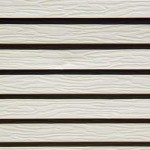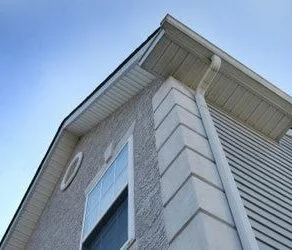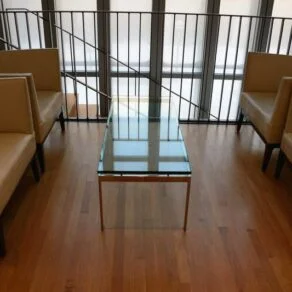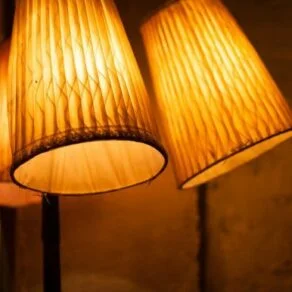Vinyl  siding has quickly become the most popular siding material in the United States. It’s durable, looks great, and doesn’t rot or flake. However, it does get a dull and dirty look over time. Fortunately, cleaning vinyl siding is an easy task to do yourself. Here’s how to make your siding look great again.
siding has quickly become the most popular siding material in the United States. It’s durable, looks great, and doesn’t rot or flake. However, it does get a dull and dirty look over time. Fortunately, cleaning vinyl siding is an easy task to do yourself. Here’s how to make your siding look great again.
Pre-Cleaning Steps
Because you will be spraying water and cleaner all around your house, there are a few things to do to protect yourself and items around your house.
- Close all windows and doors.
- Turn off power to any outside electrical units such as lights, outlets, etc.
- Cover plants such as shrubs or flowers to prevent the detergent from damaging them.
- Cover any etched glass or metal that may be damaged by cleaning solutions.
- Remove any other articles that may be in the way such as outdoor furniture or toys.
- Check over the siding for signs of mold or mildew. If you’re unsure if it’s mold, place a drop of bleach on it. If it turns white, it’s mold; if it stays dark, it’s dirt.
Cleaning Vinyl Siding
You Will Need:
- Laundry detergent
- Water
- Soft bristled brush and/or
- Broom and old towels and/or
- Sponge mop
- Large buckets (5 gallon buckets work best)
- Hose
- Pressure washer (optional)
The Cleaning Process:
- It will be easiest to work around your house in 3-5 foot sections.
- Fill a large bucket with 4 gallons of water and mix in ¼ cup of laundry detergent.
- Gather your cleaning tool, either a brush, mop or wrap an old towel around the head of a broom and secure with duct tape. You’ll want something with a long handle.
- Begin by using the hose to spray away any loose dirt and debris. If you have a pressure washer available, that can be used in place of the hose and will likely lessen (or completely eliminate) the amount of scrubbing needed. Be careful not to force water behind the vinyl panels through the seams. That could cause mold and mildew problems that are much more work to get rid of!
- Starting at the top, dip the chosen cleaning tool into the soapy water and begin scrubbing away any dirt and debris from the siding. Continue working your way down to the bottom of your section. It is important to start at the top, as the dirt will drain downwards. If you were to start at the bottom, then you would have to re-clean the bottom later to remove the dirt that drips down from the top.
- Use the hose to rinse away the soapy water. Be sure to remove all the soap before it dries or it will leave a mark on the siding.
- Continue on, repeating steps 4-7 for each section.
Removing Mineral Deposits
White hazy mineral deposits, also known as limescale, can be deposited onto your siding by sprinklers or other watering methods. Here’s how to remove the buildup.
You Will Need:
- White vinegar
- Water
- A spray bottle
- A scrub brush
Steps to Remove the Limescale:
- Mix an equal amount of white vinegar and water in a spray bottle.
- Spray the stains thoroughly with the solution.
- Let the solution sit for about 15 minutes. Do not let it dry out. Reapply more solution if needed to prevent it from drying.
- Scrub the area with a soft-bristled scrub brush. Do not use a stiff-bristle brush or scrub very hard as you don’t want to damage the siding.
- If the stains are stubborn, repeat the process using straight vinegar as many times as needed.
- Rinse the area using filtered or distilled water if possible.
Additional Tips and Advice
- If you’re concerned about putting chemicals into the ground, there are several eco-friendly detergents available to choose from as well.
- Trisodium Phosphate can also be used in place of the laundry detergent.
- Bleach can be used to remove mildew build-up present on many houses. Mix a mild solution of 1 part bleach with 5 parts water and remove by scrubbing away with a scrub brush.
- If using a ladder to clean siding near the top of your house, have an additional person available to help. Trying to scrub with a mop or broom while standing on a ladder can be extremely dangerous and should be done with extreme caution.
- Have stains that you can’t remove from your siding? The Vinyl Siding Institute offers a great list of cleaners for many kinds of stains that may be found on your vinyl.
- If your house is too big to complete yourself, you may want to have a professional clean the siding.
- Once the siding is clean, there are sealants that can be applied to prevent mold and mildew, such as Mold Armor or Moldex. These products can be found at most major supermarkets and hardware stores.








I live in SE Texas and have quite a bit of mold on my siding.
I usually brush off the siding first with a broom. Gets the webs and loose dirt off.
I mix a solution of 50% water/Clorox. Using a hand-held pump-up sprayer, I start at the eaves and spray about a 5 foot swath and work down.
Let it sit for a while, and the mold comes off with only a water spray with the hose.
Gives you time to spray a whole side and then hose off.
Whitens the whole house. I do it once every couple of years.
A relative told me that I should clean from bottom to top when scrubbing my siding to avoid streaking. I didn’t really think it would make any difference, but the next time I cleaned it, I tried it anyway. It really does help.
I live on a busy street with white siding. I spray plain water at least once a month on the bottom half of the house. This washes away the dust that is accumulated during the month from the traffic and elements.
I use a jar that has a top and screws onto the hose end. I add the soap and bleach and spray a section at a time, then rinse with another hose. I have a hard time with a long handle brush. This seems to work well.
I used to use the window cleaner that comes in a bottle and connects to your hose and then you just spray. I did the windows and everything at the same time. It worked great. Now I have brick so I only need to do my windows.
When I clean my siding, I just use a sprayer with bleach and water (2 gals. water to 1 gal. bleach). I wet a section first with water, spray the solution, wait about 5-10 minutes depending on how dirty or if there’s mold/mildew and rinse very well. Works great. Then I use a car wash attachment on my garden hose that works by siphon (like an insect/fertilizer sprayer) and I use ZipWax car wash in it. I spray it on, let it sit for about 10 minutes and rinse gently. It leaves a little bit of a protective, UV resistant wax coating on the siding and really shines it up. It’s an extra step, but well worth it!
Vinyl or wood siding should never be washed from the top down, as indicated in instructions above. If you elect to do so streaks will appear in bottom half of siding no matter how much you rinse it.
This will become more of a problem when using a bleach solution.
After 15 years of cleaning my siding, as I have described (twice a year), I have never had a problem with streaking. I prefer top to bottom rinsing because the bottom gets rinsed constantly. With bottom to top, as the water flows down the siding, it could leave a residue behind. In actuality, everything you wash should be rinsed top to bottom, even a car. Plus, you want to be careful going bottom to top, not to get an excessive amount of water in the interlocking joints. Then you could develop mold. Some vinyl siding has small holes at the bottom of the joint for moisture drainage. Bottom to top rinsing may force excessive water into these holes. The title of this post is for vinyl siding, not wood, anyway. I would never, nor do I recommend, cleaning wood siding with bleach unless it was well sealed and the paint is in excellent shape. Even then, I would be very careful. I am interested in your theory about streaking since I haven’t encountered this after 30-plus washings of my own siding and also doing neighbors homes for them.
I sell vinyl siding and have been certified by the Vinyl Siding Institute for proper installation and care practices. You should ALWAYS wash from the bottom up. If you don’t, streaking almost always happens and the streaks will not come off. The streaking occurs when there is DRY siding on the bottom and the watery dirty soapy mixture runs down onto it. If your siding has these streaks, it voids your warranty as it is a tell-tale sign that the siding was cleaned improperly. You can, however, wet down the siding first and then clean from the top down, but then you’re just doing an extra step. After it is washed, you should RINSE from the TOP to BOTTOM.
I clean everything from the top to bottom. I have never had a problem with streaking. However, I did ONCE (following instructions) try cleaning my vinyl siding from bottom to the top and had lots of streaking. The following day I had to do it again and this time I did it the way I had always done it: top first and then the bottom. Much better results and no streaking.
Bottom or top cleaning? You have read conflicting recommendations, but here is my two cents on the matter.
If you regularly clean your siding and it is not too dirty, it probably will not make a difference if you follow common sense. If the siding is not cleaned often and or if it is very dirty or has a lot of mold or tree sap stains, you probably should start from bottom to top and work in a small area (less than 30 sq ft) and rinse regularly. When you get to the higher top sections, continue to rinse the lower ends and do not just depending on the runoff from the top. Don’t forget – RINSE-RINSE-RINSE.
We scrub siding. We work top to bottom. We deal mostly with mold in the west coast of BC, Canada on the Sunshine Coast.
Our method:
We presoak the dislodged debris and soften the fungus/moss/mildew/mold dirt. We have several guys working. We use soft natural bristle brushes on a pole. We scrub sideways and even tap a tap, or brush rapidly back and forth, up and down, like a shoe shine perpendicularly onto the grain of the siding.
Pressure washers don’t get into the groves of the faux wood grain. We don’t let detergents dry. We use “Simple Green.” We used to use generic cleaner, but that was much more scrubbing. Now, we have discovered commercial mold removal products, like the ’30 Second Cleaner. But, it’s pricey. I will try bleach, borax, TSP, baking soda, and laundry detergent. Do not use laundry detergent with phosphates–that is a delicacy for mold. Tide will do nicely. And not liquid! Use powdered! Also remember…Water is your Friend! If the whole wall is kept wet, streaks aren’t a problem. Streaks could form if you tackle the top with a brush and let the concentrated cleaner dribble down the wall, remaining there longer than the cleaner you use when you’re lower, so it would be cleaning long enough to leave streaks. We never have streaks, but we keep the wall wet and work fast. It all gets done within 15 minutes.
By the way, sprinkle Tide on your roof a few times a year to kill mold. Lightly dampen it afterward with the hose so it doesn’t blow away.
Also, please don’t use newspapers to clean windows. You will streak them up, and drag lint all over them. Just ditch the idea. Newsprint ink today is made with vegetable dyes, not leaded ink. In the olden days, glass was made with lead and the leaded ink newsprint would transfer into the scratches, thus filling them. Plus, newsprint is a disaster as far as lint goes. Use paper towel (gasp! perfect every time); avoid cheep brands.
I just power washed the vinyl siding on my home yesterday. Instead of using an electric or gas powered pressure washer, I used a high velocity wand attachment for my garden hose and the results were spectacular.
In my opinion, power washers have way too much psi and can potentially cause damage and drive water behind the siding. For a cleaner, I used Clorox Pro Results Outdoor Bleach with a 1:4 ratio. If you have mildew stains on your siding, “you need bleach.” Don’t waste your money on those siding cleaners. I tried them and they did not remove the mildew without a lot of heavy brushing. With the bleach, mildew disappears right before your eyes shortly after you apply it using, for instance, a pump sprayer. Buy yourself a good soft-bristle brush with telescoping pole (example: 12′). Also, a smaller long handle brush for doing windows and hard to get areas. Be sure to put plastic over plants because the bleach will cause damage. Wet down plants thoroughly afterwords just in case there is any residual spray left behind.
Also, I completely disagree with those that say to wash from the bottom up. It makes no sense at all. You want dirt to flow from the top down. What’s key is to keep the siding being worked on completely wet and brush each panel side to side. I recommend washing on a moderately cool (calm) day, and plan to do the shady sides of the house if possible as the sun moves across the sky throughout the day.
Good luck!
I agree with Jim. Power washers can not only damage the siding, but also force water behind the panels, which can cause mold. We have a tan vinyl siding that was pretty faded and chalky. A contractor friend told us about a product called Vinyl ReNu that he uses so we got some. It came with a cleaner that got all the algae (north-facing wall) and the bird droppings off, as well as the chalky stuff. Their DIY kit (cheaper than buying contractor volume) came with the best siding cleaner we have used, but the kicker is that it also comes with a sealer/protector/restorer or whatever they call it. Our siding looks like the day it was installed. The color is back and so is the sheen. I called the manufacturer and they said that the DIY kit it is the same strength as the one professionals use and that the color would stay that way and with no algae growth for years. They said they were working on a deal with Home Depot for next year, I think. I cannot say enough about the product. It is really quite amazing! It made our grey shutters look brand new too. My wife is addicted. She is running around applying this stuff to everything.
Has anyone heard about cleaning the vinyl exterior of a house using boat cleaners?
I have heard there is a product to spray on afterwards to help prevent mildew? Thank you.
When cleaning siding, it is very important to wash from the bottom up and rinse from the top down to prevent streaking.
Siding is magical; it should be mandatory in the entire world. Cleaning siding – hooray! 😀
This thread is a bit old now, but I want to add my two cents. Washing from bottom to top is the proper way to clean anything large. When the bottom is clean, there is nothing for the dirt being rinsed from the top to stick to. Any dirt or residue left is easy to rinse off of a clean surface. I first learned that in aircraft maintenance school. Pressure washers are not recommend for vinyl siding, especially when using bleach, because if it gets under the siding, the nails will rust and the moisture draining out will cause rust-colored streaks; stains that will not come off. Bleach accelerates corrosion.
OMG!! Now I’m nervous. Yikes! I just pressure washed my house (28000/2.7 psi) using just water. I WAS standing on the ladder, aiming upwards at the siding BECAUSE the darn house is too large and too high (the second floor). I was the only one, on a short, weak, shaky ladder and there was zero way to be up that high and aiming the rod at eye-level.
I also did around the window, but not too close to the frames. Using cleaning solutions is a flat NO for me because of the plants. They DID look amazingly clean and I DID check inside for leaks; so far no problems. My siding has holes at the bottom and I did see dripping out of them, BUT I’m concerned about IF ANY water got behind the siding and how much.
I’m a young guy who is used to an apartment, so all of this is so so SO new to me. And yes, using a cleaning solution and starting from the bottom to top makes sense.
Pressure washed vinyl siding a few days ago and tried to be careful to not get water behind the siding, unsuccessfully I might add. Now, my wife says the back bedroom smells damp. Will this dry out if I do not repeat or am I in trouble?
Is there a wax to put on siding or can you use car wax?
I have yellow vinyl siding that was installed last year and this year, I had a new roof put on my house (I know the order of things is not correct, but under certain circumstances, this is how it needed to be done.) The roofers tried to be careful while tearing off the roof, but some shingles hit the siding and left dirty streak marks on it. How can I remove these without discoloring the vinyl siding? Won’t bleach cause white or lightened surface areas?
Please help!
Diane,
If properly diluted, bleach can safely be used to clean vinyl siding. However, there is no reason for you to use bleach (unless perhaps your shingles were mildewed). Just spraying off the dirt with the water hose may be sufficient, but if not, use the plain (non-bleach) laundry detergent mixture. If the dirt smudges are more like rubber scuff marks, try using an eraser or a tennis ball to rub them away.
Source: HowToCleanStuff.net – How to Remove Scuff Marks from Flooring
Power washed my vinyl siding a week ago. Now, there are dark lines where the water hit the siding. Is it possible to make this go away?
I now know less than I knew before because of all of the top first, bottom last and bottom first, top last speculation. I know one thing, when I take a shower, it’s top down ONLY. Why not just keep EVERYTHING wet, start at the top, work fast, rinse OFTEN and it makes sense that IF you do this, there shouldn’t be any chance for any streaks to occur…
We just had an our townhouse’s second floor side of the front sidings power washed recently as asked by the homeowners’s association. The small strip of that siding is adjacent to the next door’s front roof. Now, two weeks after the power wash, the neighbor complained that the power wash caused mold and bird droppings on her roof, which she claimed has never happened before. Is it possible for the mold to develop on the roof shingles after a power wash of sidings which are next to the shingles? How long does it take to have mold develop on a roof which has been exposed to frequent rains and then some sunny days alternatively in the past two weeks? And bird droppings?
All these people have said they use bleach to clean their vinyl; well, this is what I have learned. Most all vinyl is made with an oil bleach; over time, it will dry the vinyl out and make it brittle. Bleach is also the cause of the caulky residue they are commenting about as for the bottom to top method. I’m gonna have to say use common sense and you will find which way is better.
Top to bottom.
Bottom to top.
Bleach or no bleach.
Can’t some pro tell us idiots the best way?